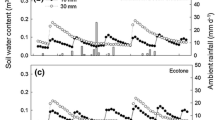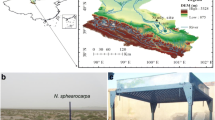Abstract
To examine the different effects of rain pulse size on uptake of summer rains by three dominant desert plants in field conditions of desertified grasslands on the Ordos Plateau of northwestern China, we studied relationships between precipitation event size and rainwater uptake using stable isotopes of hydrogen in plant and soil water. Four natural precipitation events that represented precipitation sizes of 5.3, 8.3, 13.3, and 65.3 mm in the summer were chosen for the experiment. The perennial grass Stipa bungeana, the shrub Artemisia ordosia, and the herb Cynanchum komarovii – the dominant species in the communities – were compared for their use of summer rains with different pulse sizes based on the changes in the hydrogen isotope ratios (δD) of their stem water 7 days following each natural rain event. We found that S. bungeana and C. komarovii took advantage of shallow water sources derived from small (< 10 mm) rain events, A. ordosia took advantage of deeper soil water recharged by large (> 65 mm) rain events, and C. komarovii relied primarily on rain events of intermediate (10–20 mm) size. These different responses to rain pulses among species suggested that more frequent small rain events will promote the dominance of S. bungeana and C. komarovii, medium-sized events will facilitate development of C. komarovii, and large events will advance A. ordosia in this community. The rainwater utilization patterns of the three species would allow the coexistence of S. bungeana and A. ordosia or the coexistence of A. ordosia and C. komorovii in various successional serals following the disturbances. With an increase in variability of summer rain pulse size as predicted by climate change models, we expect that the structure of this community will undergo significant change in the future. Altered precipitation regimes, especially in combination with anthropogenic-related disturbances such as over-grazing, are likely to accelerate rates of degradation in northwestern China.
Similar content being viewed by others
References
Barnes C.J., Allison G.B. (1984). The distribution of deuterium and 18O in dry soils. 3. Theory for non-isothermal water movement. Jouranl of Hydrology 74:119–135
Burgess T.L., (1995). Desert grassland, mixed shrub savanna, shrub steppe, or semidesert scrub? The dilemma of coexisting growth forms. In: McClaran M.P., Van Devender T.R., (eds) The desert grassland. University of Arizona Press, Tucson, pp. 31–67
Chen Y.F., Yu H. F., Dong M. (2002). Scale-dependent spatial heterogeneity of vegetation in Mu Us sandy land, a semiarid area of China. Plant Ecology 162:135–142
Cheng X.L., An S.Q., Li G.Q., Chen X.L., Wang Y.J., Li J. (2001a). The correlation between the desertification of grassland and the change of vegetation characteristics in Ordos. Journal of Nanjing University 37:230–239
Cheng X.L., An S.Q., Chen X.L., Li G.Q., Liu S.R. (2001b). The correlation between the desertification of grassland and the change of vegetation biomass in Ordos. Sci. Silvae Sinicae 37:13–20
Cheng X.L., An S.Q., Liu S.R., Li G.Q. (2004). Micro-scale spatial heterogeneity and the loss of carbon, nitrogen and phosphorus in degraded grassland in Ordos Plateau, northwestern China. Plant and Soil 259:29 – 37
Dodd M.B., Lauenroth W.K., Welker J.M. (1998). Differential water resources use by herbaceous and woody plant life forms in a shortgrass steppe community. Oecologia 117:504–512
Donovan L.A., Ehleringer J.R. (1994). Water stress and use of summer precipitation in a Great Basin shrub community. Functional Ecology 8:289–297
Dube O.P., Pickup G. (2001). Effects of rainfall variability and communal and semi-commercial grazing on land cover in southern African ranglands. Climate Research 17 (2):195–208
Ehleringer J.R., Schwinning S., Gebauer R. (1999). Water use in arid land ecosystems. In: Press M.C., Scholes J.D., Barker M.G., (eds). Physiological plant ecology. Blackwell Science, Boston, pp. 347–365
Flanagan L.B., Ehleringer J.R. (1991). Stable isotopic composition of stem and leaf water: Applications to the study of plant water use. Functional Ecology 5:270–277
Gao Q., Reynolds J.F. (2003). Historical shrub-grass transitions in the northern Chihuahuan Desert: Modeling the effects of shifting rainfall seasonality and event size over alandscape gradient. Global Change Biol. 9:1–19
Gonfiantini R. (1978). Standards for stable isotope measurements in natural compounds. Nature 271:534–536
Golluscio R.A., Sala O.E., Lauenroth W.K. (1998). Differential use of large summer rainfall events by shrubs and grasses: a manipulative experiment in the Patagonian steppe. Oecologia 115:17–25
Jackson P.C., Meintzer F.C., Bustamante M., Goldstein G., Franco A., Rundel P.W., Caldas L., Igler E., Causin F. (1999). Partitioning of soil water among tree species in a Brazilian Cerrado ecosystem. Tree Physiology 17:717–724
Kemp P.R., Reynolds J.F., Pachepsky Y., Chen J.K. (1997). A comparative modeling study of soil water dynamics in a desert ecosystem. Water Resource Research 33:73–90
Li X.R. (2001). Study on shrub community diversity of Ordos Plateau, Inner Mongolia, Northern China. Journal of Arid Environment 47:271–279
Lin G.H., Phillips S.L., Ehleringer J.R. (1996). Monsoonal precipitation responses of shrubs in a cold desert community on the Colorado Plateau. Oecologia 106:8–17
Reynolds J.F., Kemp P.R., Tenhunen J.D. (2000). Effects of long-term rainfall variability on evapotranspiration and soil water distribution in the Chihuahuan Desert: a modeling analysis. Plant Ecology 150:145–159
Reynolds J.F., Kemp P.R., Ogle K., Fernández R.J. (2004). Modifying the ”pulse-reserve“ paradigm for deserts of North America: precipitation pulses, soil water, and plant responses. Oecologia 141:194–210
Sala O.E., Lauenroth W.K., Parton W.J., Trlica M.J. (1981). Water status of soil and vegetation in a shortgrass steppe. Oecologia 48:327–331
Sala O.E., Lauenroth W.K., Golluscio R.A. (1997). Plant functional types in temperate semiarid regions. In: Smith T.M., Shugart H.H., Woodward F.I. (eds). Plant functional types. Cambridge University Press, Cambridge, UK, pp. 217–233
Schlesinger W.H., Raikes J.A., Hartley A.E. (1996). On the spatial pattern of soil nutrients in desert ecosystem. Ecology 77:364–374
Schlesinger W.H., Ehleringer J.R. (2001).Water use trade-offs and optimal adaptations to pulse-driven arid ecosystems. Journal of Ecology 89:464–480
Schwinning S., Davis K., Richardson L., Ehleringer J.R. (2002). Deuterium enriched irrigation indicates different forms of rain use in shrub/grass species of the Colorado Plateau. Oecologia 130:345–355
Schwinning S., Starr B.I., Ehleringer J.R. (2003). Dominant cold desert plants do not partition warm season precipitation by events size. Oecologia 136:252–260
Schenk H.J., Jackson R.B. (2002). Rooting depths, lateral root spreads and below-ground/above-ground allometries of plants in water-limited ecosystems. Journal of Ecology 90:480–494
Snyder K.A., Williams D.G. (2003). Defoliation alters water uptake by deep and shallow roots of Prosopis velutina (Velvet Mesquite). Functional Ecology 17:363–374
Walter H. (1971). Natural savannahs as a transition to the arid zone. In: Burnett J.H. (eds). Ecology of Tropical and Subtropical Vegetation. Van Nostrand Reinhold Co., New York, pp. 238–265
Williams D.G., Ehleringer J.R. (2000). Intra- and interspecific variation for summer precipitation use in pinyon-juniper wood-lands. Ecology Monograph 70:517–537
Yang B.Z., Dong X.J., Gong Q., Liu Z.M., Ai D.B. (1994). A study on the transpiration and water-defict regime of the Artemisia Ordosica community. Acta Phytoecology Sinicae 18:161–170
Yoder C.K., Boutton T.W., Thurow T.L., Midwood A.J. (1998). Differences in soil water use by annual broomweed and grasses. Journal of Range Management 51:200–206
Zhang X.S. (1994). The optimization pattern and principle of grassland construction and ecological background of Maomusu sandland. Acta Phytoecology Sinicae 18:1–16
Zheng H.L., Huang Z.C. (1992). Physiological ecology study on Artemisia Ordosica and Cynanchum Komarovii in the maowusu sandland. Acta Phytoecology et Geobotany Sinicae 16:197–207
Acknowledgements
The work partially was supported by the National Basic Research Projects (2002CB111504), the Major Project of the National Natural Science Foundation of China (39990490), and the Chinese Academy of Sciences through CAS's Bairen Program (G. Lin). We thank Mr Yaosheng Huang, Dongsheng Ma and Yuanwu Zhuo for their assistances in the field sampling and lab analysis. Jim Clark, James Ehleringer, and Amy Concilio provided constructive and valuable suggestions for improving the quality of an earlier version of this manuscript.
Author information
Authors and Affiliations
Corresponding author
Rights and permissions
About this article
Cite this article
Cheng, X., An, S., Li, B. et al. Summer rain pulse size and rainwater uptake by three dominant desert plants in a desertified grassland ecosystem in northwestern China. Plant Ecol 184, 1–12 (2006). https://doi.org/10.1007/s11258-005-9047-6
Received:
Accepted:
Published:
Issue Date:
DOI: https://doi.org/10.1007/s11258-005-9047-6




